Yukon Arctic Ultra
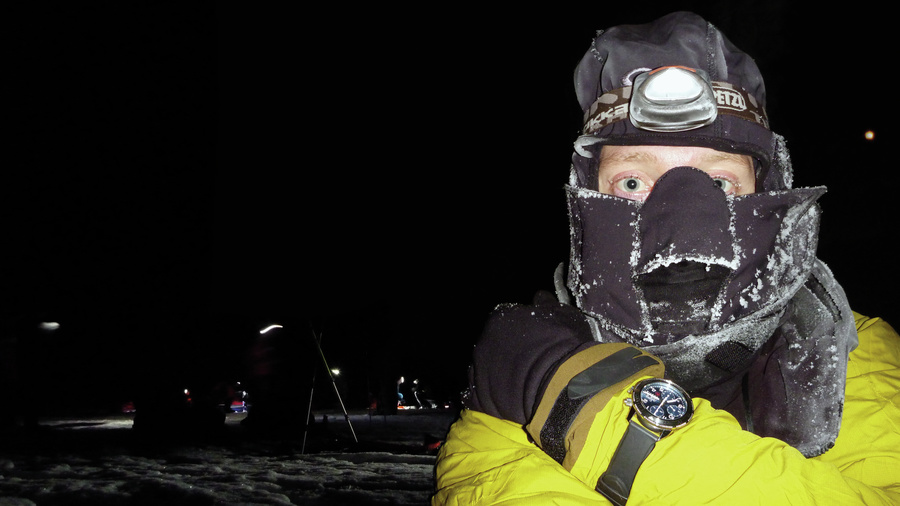
- How a NaBo 17 ZM survived a Tornado crash
- SINN watches accompany a world record
- Emergency doctor Martin Leitl
- Raffael Zeller at the Fulda Challenge
- Wreck diver Andreas Peters
- EZM 10 and 103 Ti Ar on board EC 145 T2
- Extreme sportsman Raffael Zeller
- Polar Explorer Arved Fuchs
- Glider Pilot Susanne Schödel and her 356 Sa FLIEGER UTC
- Aerobatic Pilot Ralf Niebergall
- Tim Thompson from Canada
- Alpinist Christian Moser
- Jörg Knillmann on a special tour
- Arctic adventure
The 203 ARKTIS and the world's coldest race
The adventures of Dominik Luksch provide further evidence that SINN watches can withstand even the toughest weather conditions. He took part in the Yukon Arctic Ultra, the coldest and most arduous race in the world – and relied SINN model 203 ARKTIS. He completed the 100-mile course on foot in 65 hours, pulling his equipment behind him on a sled. His journal provides insights into the kind of stress he and his watch were subjected to.
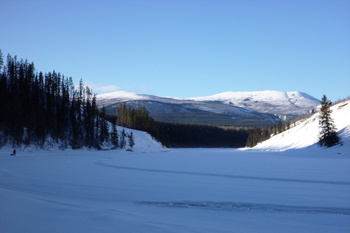
Day 1 “Set out from Whitehorse, Canada, at 10:30 a.m. on 6 February 2011. The first 40 kilometers were flat and followed the course of the Yukon River. I found myself on an icy surface winding its way through the landscape. I reached the first checkpoint after seven hours. Had some soup, a sandwich and some cake, then continued down the Yukon. Because the sun was no longer shining, I needed a raincoat, rain trouser and protection for my face. The temperature sank to minus 35 degrees Celsius! My breath froze immediately when it came in contact with textiles or hair. My face protection froze immediately after I put it on. Icicles formed, and my eyelids stuck together if I kept them closed for more than a second. I kept going until the trail left the river and started getting hilly. Because it was getting a bit too strenuous, I stopped and set up my bivouac. Quickly unrolled my sleeping bag and thermal mat and got into my warm bed. The first night was almost too much for me! Extremely cold temperatures, so I even had to leave my face protection on all night.”
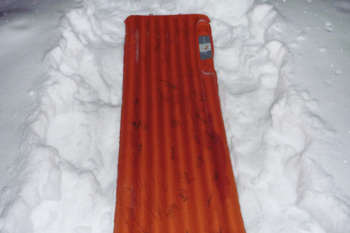
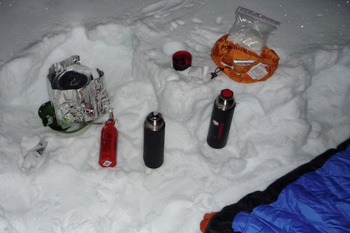
Day 2 “Getting up in the morning is torture when it means getting out of the warm sleeping bag and exposing yourself to the cold. For breakfast I had chocolate and tea, but the lid of my thermos froze stuck. I had to fire up my cooker and thaw out the pot. At about 6 a.m. it was time to get started. I'm beginning to notice how strenuous the trail is. It's uphill and down the whole time. On the way up the sled gets heavier and heavier, and on the way down it pushes me forward. My diet consists primarily of fat and sugar. But no matter how much I eat, an hour later I get hungry again, although my stomach is still full. I'm getting slower and slower; my uphill climbs are in slow motion. At the second checkpoint I packed some food and dried my face protector. After resting for an hour I continued on my way, keeping an eye out for a place to spend my second night in the cold. Found a place to camp, and blew up my insulating mattress before trying to fire up my cooker. After some initial difficulties I succeeded, but by that time the air had gone out of my mattress. So I had to blow it up again before I could lie down. Woke up an hour later and wondered why my back was so cold. The air had gone out of my mattress again! I blew it up one more time, but an hour later it was flat again. This time I didn't waste any more air on it, but just put on my thermal pants and went back to sleep.”
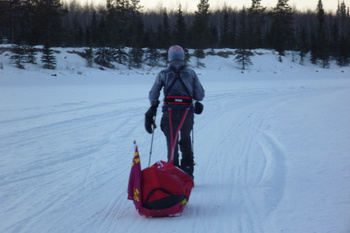
Day 3 “The next morning, walking was even more difficult. The sled was heavy, my back hurt and my strength waned. Every kilometer toward the goal was a struggle. Around noon I was exhausted and took a long break. According to plan, I was supposed to reach the checkpoint between 2 and 6 p.m. I remained optimistic, but about an hour and a half after lunch I was overcome by exhaustion once again, and my pace slowed drastically. Sometimes I was so slow that swimming would have been faster. On top of everything else, I started to notice a throbbing pain in my right heel. But I had to keep going. Another hour and a half later I found myself in another slump. I wanted to continue, but I couldn't take another step. So I took out my sleeping bag and collapsed on top of my sled.”
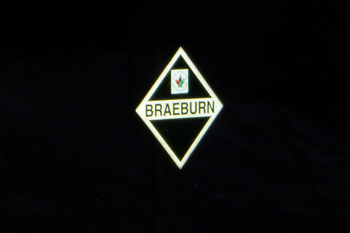
Day 4 “Woke up at 2 in the morning, thinking, I'm supposed to be at the goal line at 10:30 a.m.! So I got back under way at a pretty fast pace, but with pain in my heel and knee. My GPS said it was another four kilometres to the next checkpoint. The trail was getting worse. Uphill and down, an arduous ordeal, especially when you're totally exhausted. Suddenly the path led downhill to a frozen lake. On the level surface the going was easier, but eventually I reached the other side of the lake, and the steep bank was a challenge. The snow was soft and my heavy equipment weighed me down; I had to use my hands and crawl up. Then the path led through a forest, always uphill and down. Suddenly I spied a sign of civilization: a utility pole and an illuminated transformer building! Soon afterwards I was elated to find a road and a sign saying Braeburn. The roadhouse was just 30 meters away, and I could see the banner of the finish line. I took a quick photo, and then hurried to the finish line. I could hardly believe it! Now it's 3:30 in the morning, and I'm exhausted but I can't sleep. At about nine I'll get in a car for the trip back to Whitehorse.”
The Yukon Arctic Ultra The trail of the Yukon Arctic Ultra follows the course of the Yukon Quest, the world's most demanding dogsled race. There are four distances to choose from (marathon, 100 miles, 300 miles, 430 miles), which are to be completed within a given time using a mountain bike, cross country skis or on foot. The various disciplines may not be combined. The trail is clearly marked, but in case of falling or drifting snow the markings can be difficult to find. Sometimes they get run over or removed. Due to the extremely cold temperatures in the Yukon wilderness, the non-stop nature of the race and the vast distances involved, the Yukon Arctic Ultra is the world's coldest and toughest ultra-race. Situations that would normally present no problem can be life-threatening here. Source: www.arcticultra.de.
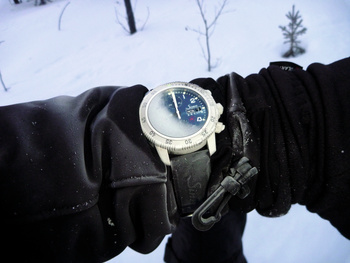
The 203 ARKTIS The Yukon Arctic Ultra represents a tremendous challenge for its participants and their equipment. Reliable measuring of time play a vital role, as the participants always need to know what time it is, how long they've been underway and whether they are within their time plan. Dominik Luksch relied on the 203 ARKTIS, the diving chronograph featuring Temperature Resistance Technology. During the race he wore the watch outside of his protective clothing at all times, which meant it was totally exposed to the elements. The watch was reliable even during the night thanks to its optimal readability. The watch's accuracy was absolutely remarkable, with a deviation of just 0.625 seconds per day. After the race, Dominik Luksch was convinced: “This watch is a reliable, accurate instrument that I wouldn't have wanted to be without.”